Amsterdam and Poland 2017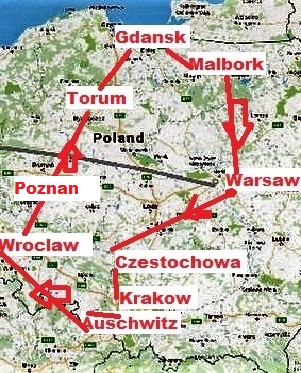
Day 13, Friday, June 16
Torun
to Gdansk
This
morning we had to have our bags out
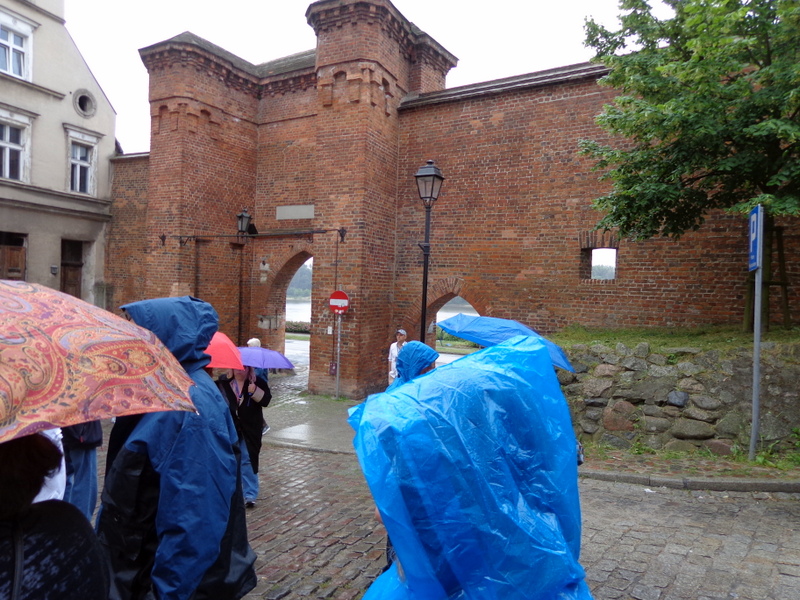 by 8:30.
We met our city guide for a two hour
walking tour of Torun. Torun has a very fine wall around most of the
city, so we followed that for a while. It had sprinkled a bit when we
started out and then rained harder for a few minutes, then the sun came
out. Near the wall were the ruins of a castle of the Teutonic Knights.
by 8:30.
We met our city guide for a two hour
walking tour of Torun. Torun has a very fine wall around most of the
city, so we followed that for a while. It had sprinkled a bit when we
started out and then rained harder for a few minutes, then the sun came
out. Near the wall were the ruins of a castle of the Teutonic Knights.
THE CASTLE OF THE TEUTONIC KNIGHTS
It is one of the oldest of the castles of the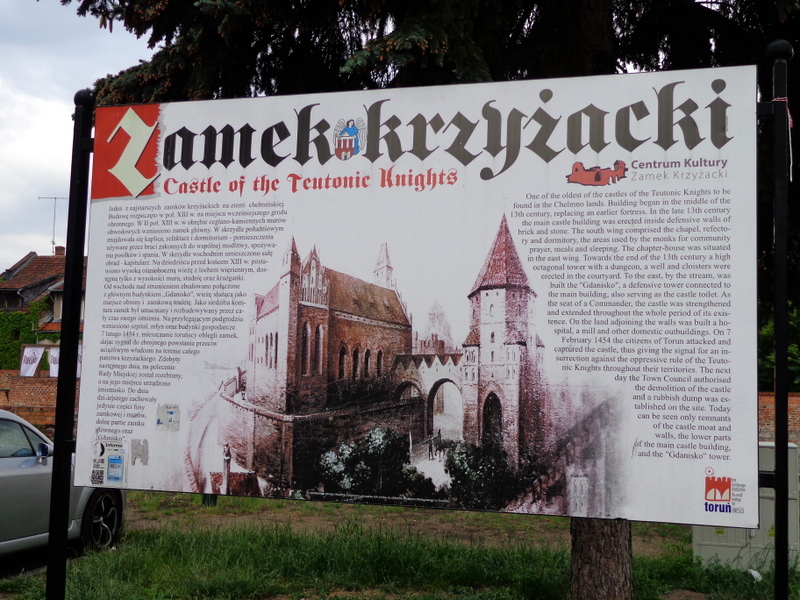 Teutonic Knights.
Building began in the middle of
the 13th century. In the late 13th century, the
main castle building was erected inside the walls of brick and stone.
Teutonic Knights.
Building began in the middle of
the 13th century. In the late 13th century, the
main castle building was erected inside the walls of brick and stone.
The South wing contained the chapel, refractory and dormitory, the area
used by the monks for community prayer, meals, and sleeping. The chapter
house was situated in the east wing.
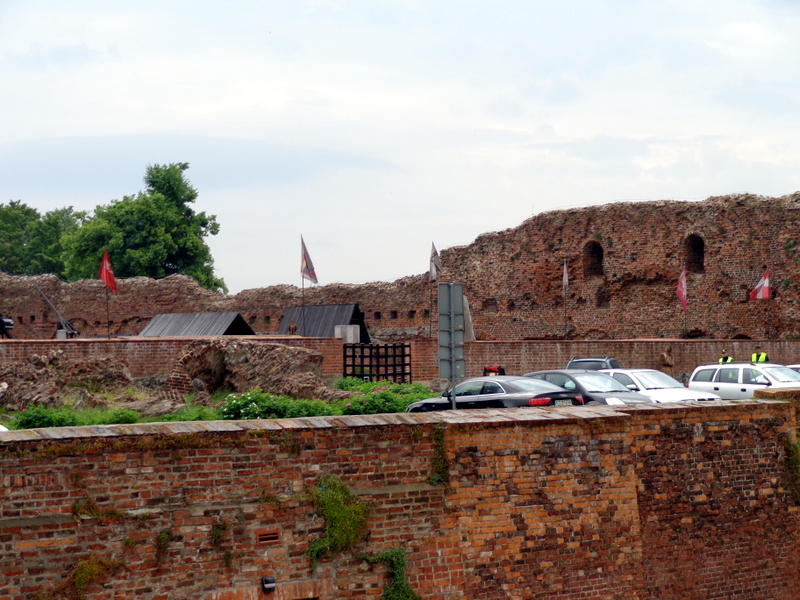 Towards
the end of the 13th century, a high octagonal tower with a
dungeon, as well as a cloister was erected in the courtyard. To the east,
by the stream, was built the “Gdanisko”, a defensive tower connected to
the main building.
Towards
the end of the 13th century, a high octagonal tower with a
dungeon, as well as a cloister was erected in the courtyard. To the east,
by the stream, was built the “Gdanisko”, a defensive tower connected to
the main building.
On 7
February 1454, the citizens of Torun attacked and captured the Castle,
thus giving the signal for insurrection against the oppressive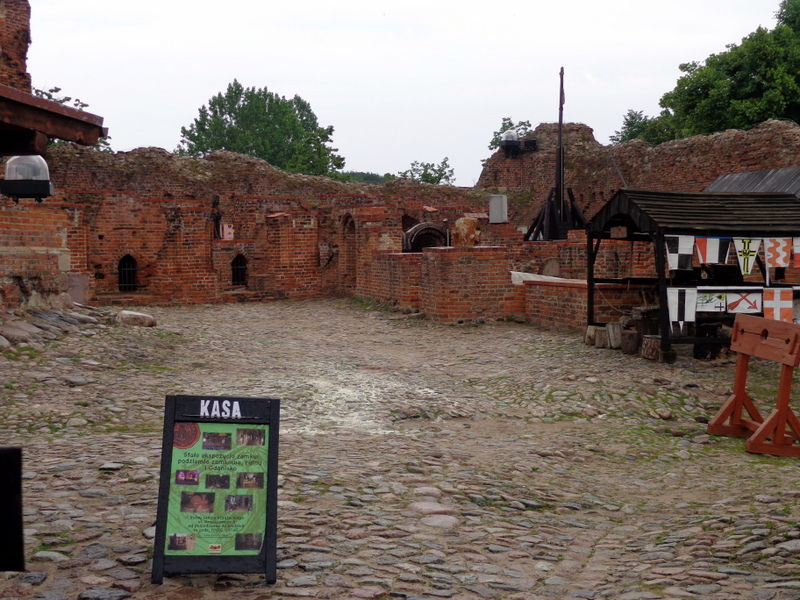 rule of
the Teutonic Knights throughout their territory. The next day the Town
Council authorized demolition of the Castle into a rubbish dump.
rule of
the Teutonic Knights throughout their territory. The next day the Town
Council authorized demolition of the Castle into a rubbish dump.
Today we can only see the
ruins of the castle moat and walls, the lower parts of the main
castle building and the “Gdanisko”.
COPERNICUS' BIRTH HOME
Copernicus was born in Torun, and we walked past the house of his birth.
There was a long line waiting to get in. It was not part of our tour. It
was an interesting looking house from the exterior.
 Copernicus’
house is a medieval burgher’s house, which belonged to the Copernicus
family in the 2nd half of the 15th century. Many
historians point to the house as the birthplace (1473) of the renowned
astronomer Nicholas Copernicus.
Copernicus’
house is a medieval burgher’s house, which belonged to the Copernicus
family in the 2nd half of the 15th century. Many
historians point to the house as the birthplace (1473) of the renowned
astronomer Nicholas Copernicus.
The present appearance of the Copernicus House
comes from the 15th century. The façade features a pointed Gothic arch
portal, brick friezes and vertical niches adorned with painted
two-colored patterns characteristic for medieval Torun. The house, like
houses in other Hanseatic League towns, served simultaneously as a
residence and a storehouse.
Currently, the house and the adjacent Gothic
building house a branch of the District Museum called Nicolaus
Copernicus' House. The house displays a medieval layout, interior
decorations and furnishings typical for the period from the 15th to the
18th century. Apart from the Copernicus family artifacts, it features a
collection of various editions of Copernicus' groundbreaking work called
"De Revolutionibus" and objects documenting the diverse interests and
activities of the great scholar in the first half of the 15th century.
The Gothic Cathedral of St. John the
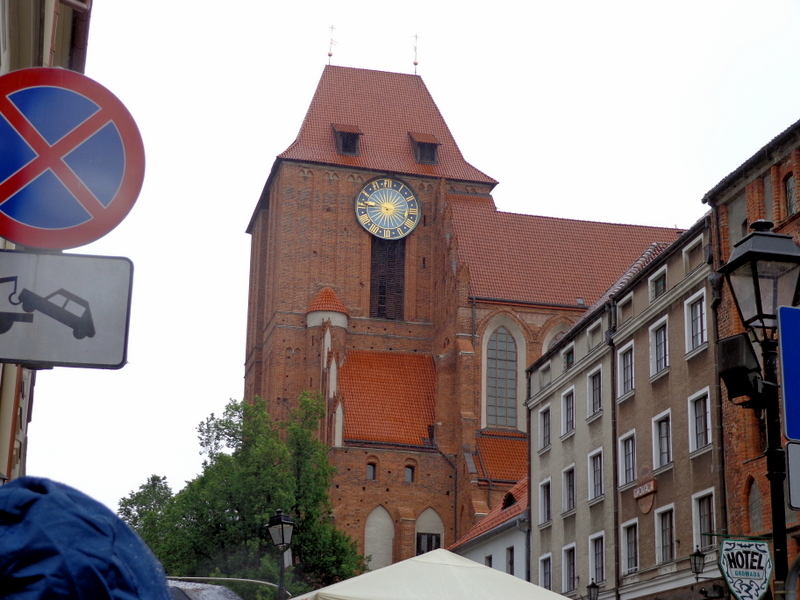 Baptist and St. John the Evangelist
received its present-day shape as a result of the multi-stage
construction which was interrupted at the turn of the 16th century,
after 200 years of work. In the Middle Ages it was the most important
church in Torun. It brought together worshippers from the entire town.
Baptist and St. John the Evangelist
received its present-day shape as a result of the multi-stage
construction which was interrupted at the turn of the 16th century,
after 200 years of work. In the Middle Ages it was the most important
church in Torun. It brought together worshippers from the entire town.
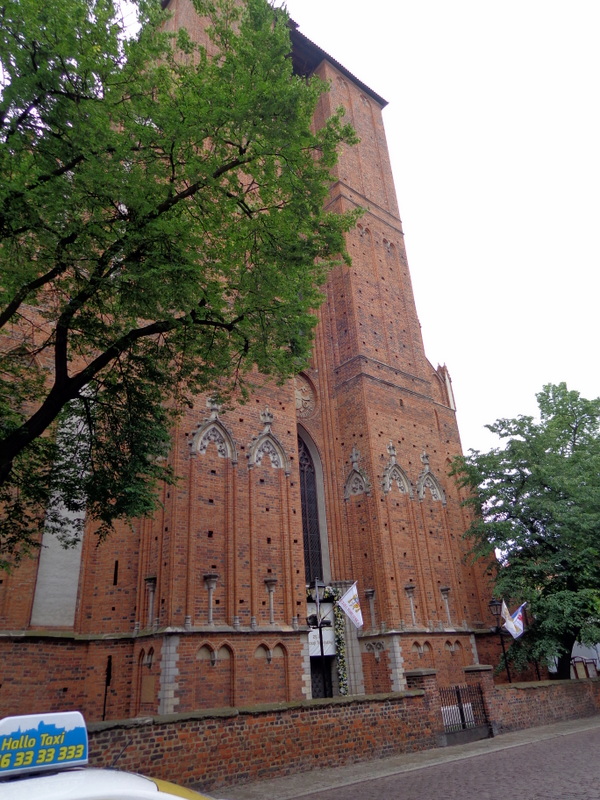 In mid-16th century it was temporarily taken
over by Lutherans, later, for several years, it served as a place of
worship for both denominations as both the Protestant and Roman Catholic
services were held there. From the late 16th century to the second half
of the 18th century the church was in the possession of Jesuits. In 1992
the church received the status of a cathedral basilica – the main church
of the Torun diocese formed by the Pope John Paul II.
In mid-16th century it was temporarily taken
over by Lutherans, later, for several years, it served as a place of
worship for both denominations as both the Protestant and Roman Catholic
services were held there. From the late 16th century to the second half
of the 18th century the church was in the possession of Jesuits. In 1992
the church received the status of a cathedral basilica – the main church
of the Torun diocese formed by the Pope John Paul II.
The spacious interior of the church is filled
with masterpieces of sacred art. Ther e are 14th century Gothic paintings
depicting the patron saints of the church – St. John the Baptist and St.
John the Evangelist, as well as a monumental, multi-theme medieval
painting showing the Last Judgement. The high altar of St. Wolfgang, the
stained-glass windows and the soaring vault also date back to the
medieval times.
e are 14th century Gothic paintings
depicting the patron saints of the church – St. John the Baptist and St.
John the Evangelist, as well as a monumental, multi-theme medieval
painting showing the Last Judgement. The high altar of St. Wolfgang, the
stained-glass windows and the soaring vault also date back to the
medieval times.
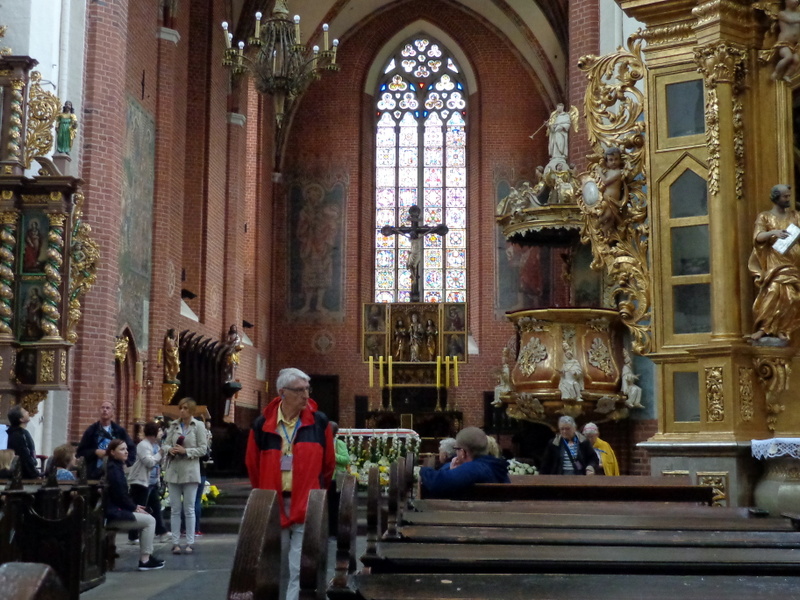 The nave and the aisles of the cathedral
contain several Renaissance and Baroque altars and numerous epitaphs of
Torun burghers and noblemen from the surrounding area.
The nave and the aisles of the cathedral
contain several Renaissance and Baroque altars and numerous epitaphs of
Torun burghers and noblemen from the surrounding area.
We
spent some time on our own exploring the cathedral. After walking around
a little more of Torun, we boarded our bus for the 2 hour trip to
Gdansk.
WESTERPLATTE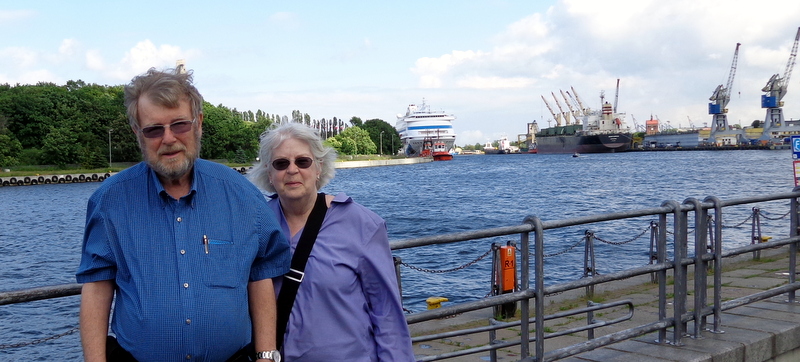
Our
first stop, as we approached Gdansk, was Westerplatte where the first
shots of WWII were fired against Poland by the Germans.
The first battle of World War II started on September 1, 1939, at 4:48
am, when the German battleship Schleswig-Holstein let loose a barrage of
artillery onto the Polish naval
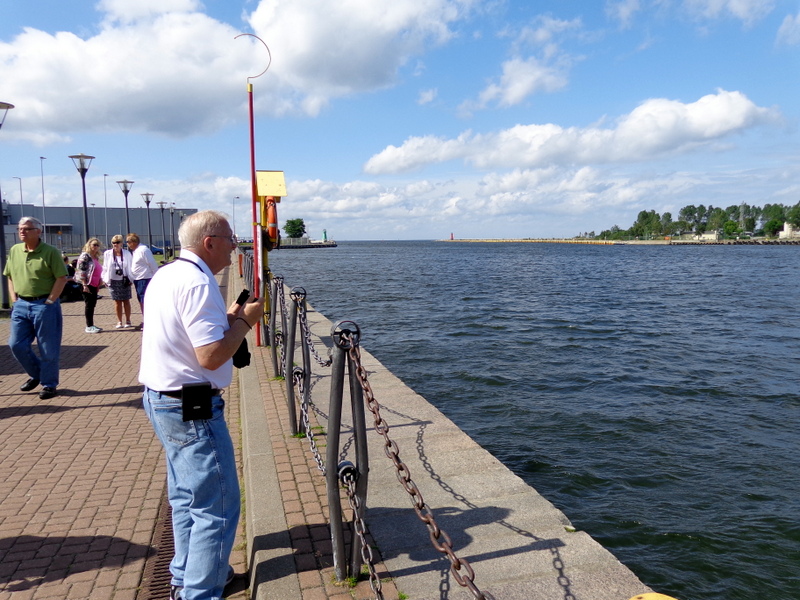 depot, Westerplatte.
depot, Westerplatte.
Even
though Westerplatte was tiny and poorly guarded, it was a surprise to
few that this would become the site of the first battle of a war long in
the making. Within the Free City of Danzig (Gdańsk,
today), Nazi support was at an all-time high among the largely German
local population, which Hitler’s government had been trying to annex
into the Third Reich for years. Westerplatte was the location of the
only Polish military presence in the area.
Provisions
stip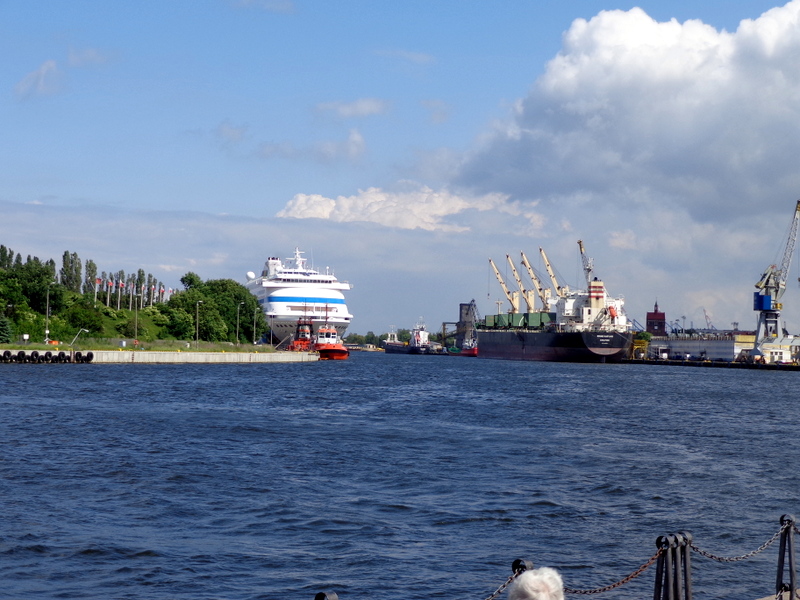 ulated in the Treaty of Versailles limited the strength of the
Westerplatte compound to just 88 Polish soldiers. Against the treaty and
in preparation of the ensuing violence, the Polish naval garrison began
reinforcing their meager existing fortifications with machine guns,
mortars, and antitank weaponry while the number of soldiers stationed
there was nearly tripled.
ulated in the Treaty of Versailles limited the strength of the
Westerplatte compound to just 88 Polish soldiers. Against the treaty and
in preparation of the ensuing violence, the Polish naval garrison began
reinforcing their meager existing fortifications with machine guns,
mortars, and antitank weaponry while the number of soldiers stationed
there was nearly tripled.
The Germans won the battle, but against all
odds. The outnumbered and outgunned Polish soldiers were able to keep a
force more than ten times their number at bay for seven days. In the
end, of the 3,400 Germans who took part in the battle, 300 died. Only
around 15 of the 210 Polish forces perished.
SOLIDARITY MUSEUM
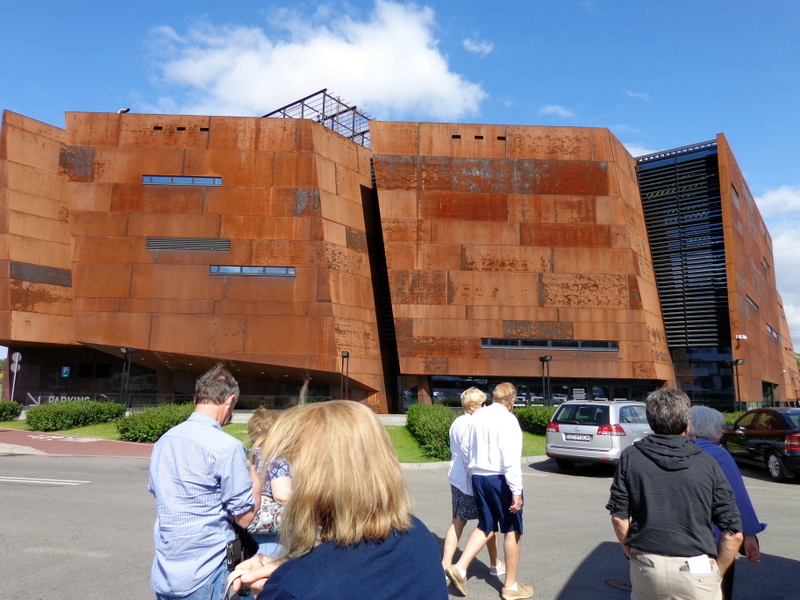 Next we stopped at the Solidarity Museum which was designed to look like
rusted metal.
Next we stopped at the Solidarity Museum which was designed to look like
rusted metal.
The
Solidarity Museum is just to the north of the city center. It is
dedicated to the Solidarity movement, that was created by the former
ship yard worker Lech Walesa.
The
museum is housed in a futuristic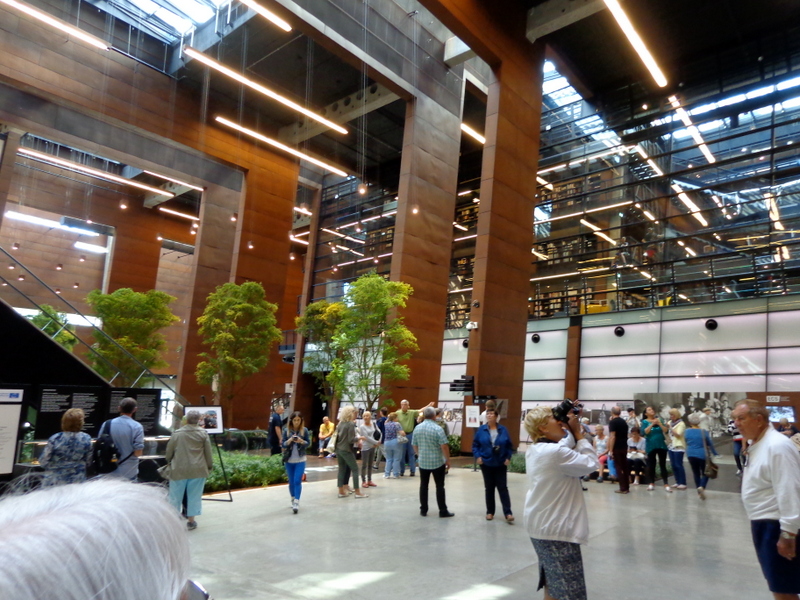 five-story building which contains a
permanent exhibition about Solidarity and the opposition, that led to
the Democratic transformation of Poland and Eastern Europe. The building
is built with rust colored sheet metal reminiscent of a ship’s hull. We
only had a short time to visit inside the museum, but what we saw was
very interesting.
five-story building which contains a
permanent exhibition about Solidarity and the opposition, that led to
the Democratic transformation of Poland and Eastern Europe. The building
is built with rust colored sheet metal reminiscent of a ship’s hull. We
only had a short time to visit inside the museum, but what we saw was
very interesting.
Outside
there are several interesting statues and monuments.
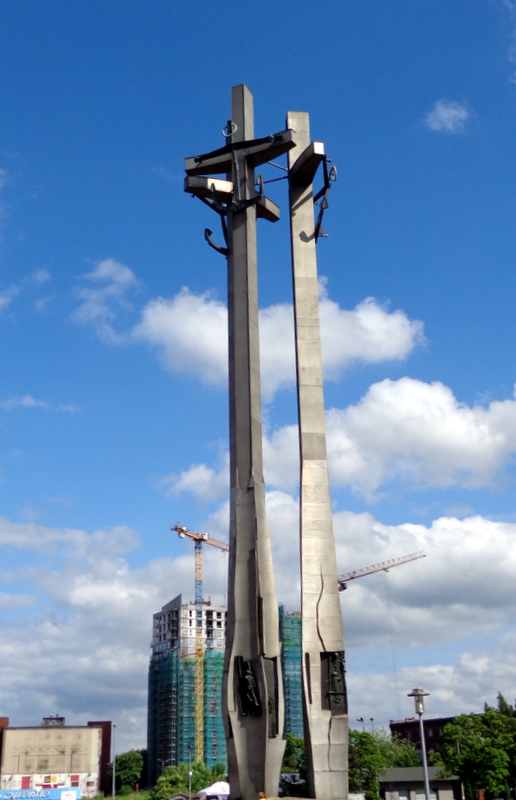 There is a large
monument composed of 3 crosses with anchors attached known as the
Solidarity Monument. It symbolizes the workers struggle and is a
memorial for the ones who died during the strikes. The Solidarity
movement was created by Walesa to protest the poor working conditions
for the workers at the Lenin shipyard (today, Gdansk shipyard) in the
early 1970s. In 1980 the big strikes at the shipyard led to protests all
over Eastern Europe, and finally led to the fall of the communist regime
in Poland. Solidarity became a political party with Lech Walesa as its
leader. Between 1990 and 1995, he was the president of Poland.
There is a large
monument composed of 3 crosses with anchors attached known as the
Solidarity Monument. It symbolizes the workers struggle and is a
memorial for the ones who died during the strikes. The Solidarity
movement was created by Walesa to protest the poor working conditions
for the workers at the Lenin shipyard (today, Gdansk shipyard) in the
early 1970s. In 1980 the big strikes at the shipyard led to protests all
over Eastern Europe, and finally led to the fall of the communist regime
in Poland. Solidarity became a political party with Lech Walesa as its
leader. Between 1990 and 1995, he was the president of Poland.
 From the Solidarity
From the Solidarity Museum, we went directly to our hotel which is a
five-star Radisson. We had a very attractive large room
Museum, we went directly to our hotel which is a
five-star Radisson. We had a very attractive large room
We
had some free time before dinner, so we walked around.
We were just a few feet from the gate that leads to the river and the famous section
of the waterfront that I have made the model of. CLICK HERE TO SEE
MY MODEL. It looks just
like the
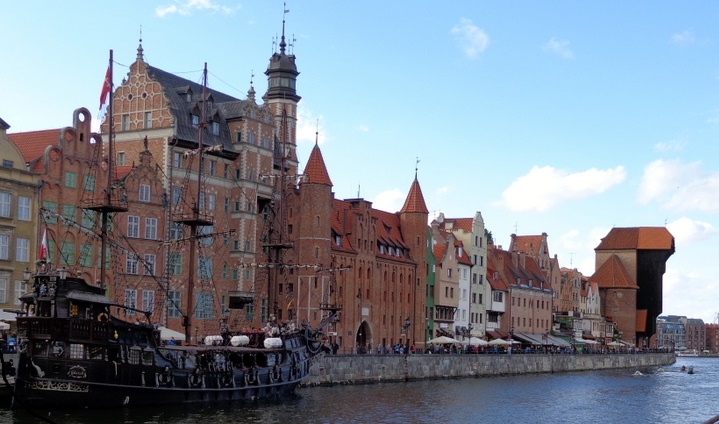 model--
model--
We walked on the opposite of the river inorder to photograph all
of the buildings and the famous crane.
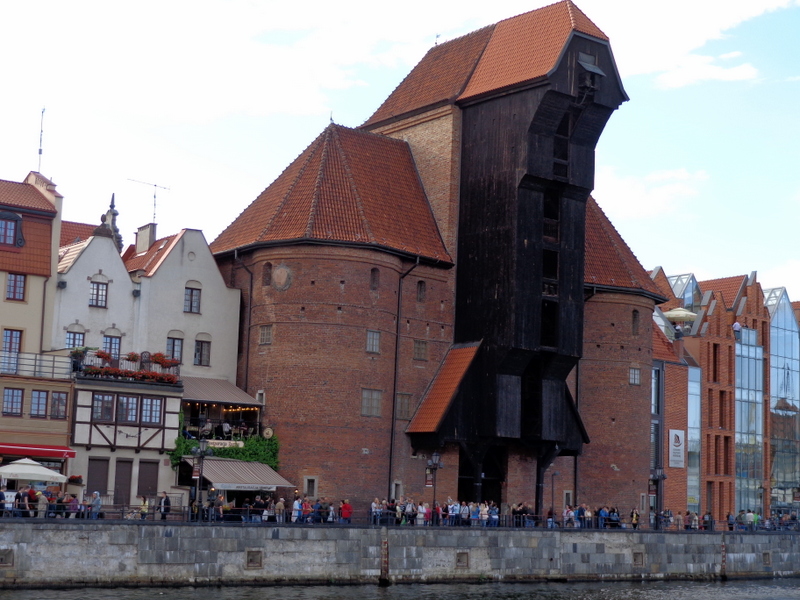
The Gdansk crane dates back to 14th century. It goes back to the
time when Gdansk was in the Hanseatic League, and could load and unload
four tons of cargo. SEE
MY MODEL
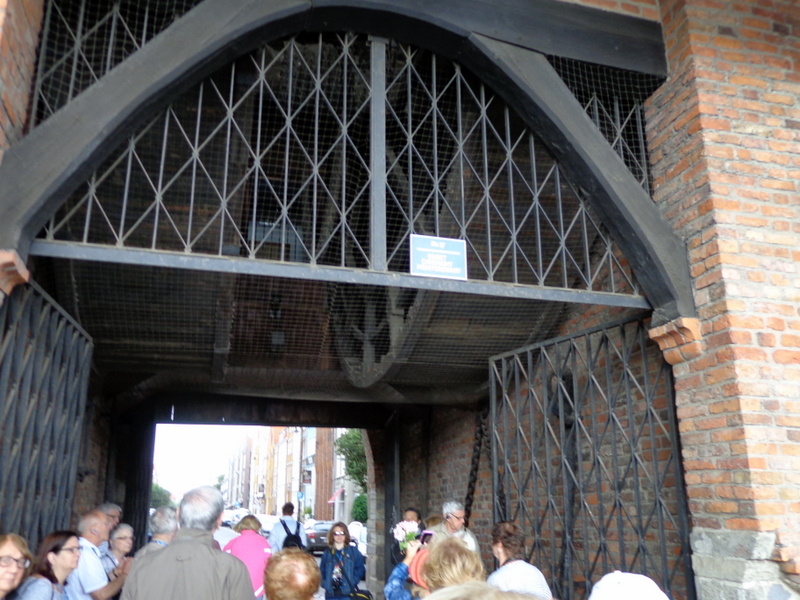
The power came from humans, as groups of men would walk inside two large
wooden wheels, as if they were hamsters. The crane also doubled as
a waterside city gate. Note the two wheels above the folks going through
the gate.
We
came back for the group dinner in our hotel. It was a buffet with
fish, chicken, potatoes, pierogis (like dumplings filled with good
things) and green beans. There was a huge salad bar and two
delicious pastries for dessert. After dinner we walked along the
river and got back to the room about 9:00.
We
sure do a lot of walking on this trip. We walked about 5 miles today.
Sometime we think that we are getting too old for such activities, but
we are having fun. Tomorrow we have the whole day in Gdansk.
Day 15 coming soon

 by 8:30.
We met our city guide for a two hour
walking tour of Torun. Torun has a very fine wall around most of the
city, so we followed that for a while. It had sprinkled a bit when we
started out and then rained harder for a few minutes, then the sun came
out. Near the wall were the ruins of a castle of the Teutonic Knights.
by 8:30.
We met our city guide for a two hour
walking tour of Torun. Torun has a very fine wall around most of the
city, so we followed that for a while. It had sprinkled a bit when we
started out and then rained harder for a few minutes, then the sun came
out. Near the wall were the ruins of a castle of the Teutonic Knights.
 Teutonic Knights.
Building began in the middle of
the 13th century. In the late 13th century, the
main castle building was erected inside the walls of brick and stone.
Teutonic Knights.
Building began in the middle of
the 13th century. In the late 13th century, the
main castle building was erected inside the walls of brick and stone.

 rule of
the Teutonic Knights throughout their territory. The next day the Town
Council authorized demolition of the Castle into a rubbish dump.
rule of
the Teutonic Knights throughout their territory. The next day the Town
Council authorized demolition of the Castle into a rubbish dump. 
 Baptist and St. John the Evangelist
received its present-day shape as a result of the multi-stage
construction which was interrupted at the turn of the 16th century,
after 200 years of work. In the Middle Ages it was the most important
church in Torun. It brought together worshippers from the entire town.
Baptist and St. John the Evangelist
received its present-day shape as a result of the multi-stage
construction which was interrupted at the turn of the 16th century,
after 200 years of work. In the Middle Ages it was the most important
church in Torun. It brought together worshippers from the entire town.
 In mid-16th century it was temporarily taken
over by Lutherans, later, for several years, it served as a place of
worship for both denominations as both the Protestant and Roman Catholic
services were held there. From the late 16th century to the second half
of the 18th century the church was in the possession of Jesuits. In 1992
the church received the status of a cathedral basilica – the main church
of the Torun diocese formed by the Pope John Paul II.
In mid-16th century it was temporarily taken
over by Lutherans, later, for several years, it served as a place of
worship for both denominations as both the Protestant and Roman Catholic
services were held there. From the late 16th century to the second half
of the 18th century the church was in the possession of Jesuits. In 1992
the church received the status of a cathedral basilica – the main church
of the Torun diocese formed by the Pope John Paul II. e are 14th century Gothic paintings
depicting the patron saints of the church – St. John the Baptist and St.
John the Evangelist, as well as a monumental, multi-theme medieval
painting showing the Last Judgement. The high altar of St. Wolfgang, the
stained-glass windows and the soaring vault also date back to the
medieval times.
e are 14th century Gothic paintings
depicting the patron saints of the church – St. John the Baptist and St.
John the Evangelist, as well as a monumental, multi-theme medieval
painting showing the Last Judgement. The high altar of St. Wolfgang, the
stained-glass windows and the soaring vault also date back to the
medieval times.  The nave and the aisles of the cathedral
contain several Renaissance and Baroque altars and numerous epitaphs of
Torun burghers and noblemen from the surrounding area.
The nave and the aisles of the cathedral
contain several Renaissance and Baroque altars and numerous epitaphs of
Torun burghers and noblemen from the surrounding area. 
 depot, Westerplatte.
depot, Westerplatte. ulated in the Treaty of Versailles limited the strength of the
Westerplatte compound to just 88 Polish soldiers. Against the treaty and
in preparation of the ensuing violence, the Polish naval garrison began
reinforcing their meager existing fortifications with machine guns,
mortars, and antitank weaponry while the number of soldiers stationed
there was nearly tripled.
ulated in the Treaty of Versailles limited the strength of the
Westerplatte compound to just 88 Polish soldiers. Against the treaty and
in preparation of the ensuing violence, the Polish naval garrison began
reinforcing their meager existing fortifications with machine guns,
mortars, and antitank weaponry while the number of soldiers stationed
there was nearly tripled. Next we stopped at the Solidarity Museum which was designed to look like
rusted metal.
Next we stopped at the Solidarity Museum which was designed to look like
rusted metal.  five-story building which contains a
permanent exhibition about Solidarity and the opposition, that led to
the Democratic transformation of Poland and Eastern Europe. The building
is built with rust colored sheet metal reminiscent of a ship’s hull. We
only had a short time to visit inside the museum, but what we saw was
very interesting.
five-story building which contains a
permanent exhibition about Solidarity and the opposition, that led to
the Democratic transformation of Poland and Eastern Europe. The building
is built with rust colored sheet metal reminiscent of a ship’s hull. We
only had a short time to visit inside the museum, but what we saw was
very interesting. There is a large
monument composed of 3 crosses with anchors attached known as the
Solidarity Monument. It symbolizes the workers struggle and is a
memorial for the ones who died during the strikes. The Solidarity
movement was created by Walesa to protest the poor working conditions
for the workers at the Lenin shipyard (today, Gdansk shipyard) in the
early 1970s. In 1980 the big strikes at the shipyard led to protests all
over Eastern Europe, and finally led to the fall of the communist regime
in Poland. Solidarity became a political party with Lech Walesa as its
leader. Between 1990 and 1995, he was the president of Poland.
There is a large
monument composed of 3 crosses with anchors attached known as the
Solidarity Monument. It symbolizes the workers struggle and is a
memorial for the ones who died during the strikes. The Solidarity
movement was created by Walesa to protest the poor working conditions
for the workers at the Lenin shipyard (today, Gdansk shipyard) in the
early 1970s. In 1980 the big strikes at the shipyard led to protests all
over Eastern Europe, and finally led to the fall of the communist regime
in Poland. Solidarity became a political party with Lech Walesa as its
leader. Between 1990 and 1995, he was the president of Poland. From the Solidarity
From the Solidarity Museum, we went directly to our hotel which is a
five-star Radisson. We had a very attractive large room
Museum, we went directly to our hotel which is a
five-star Radisson. We had a very attractive large room model--
model-- 